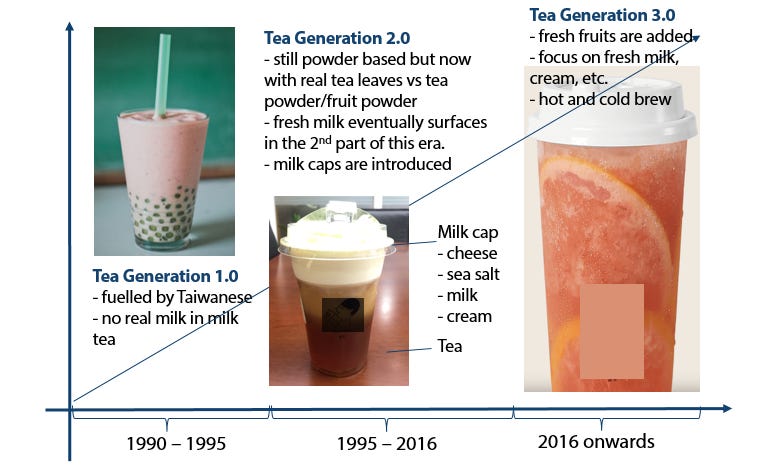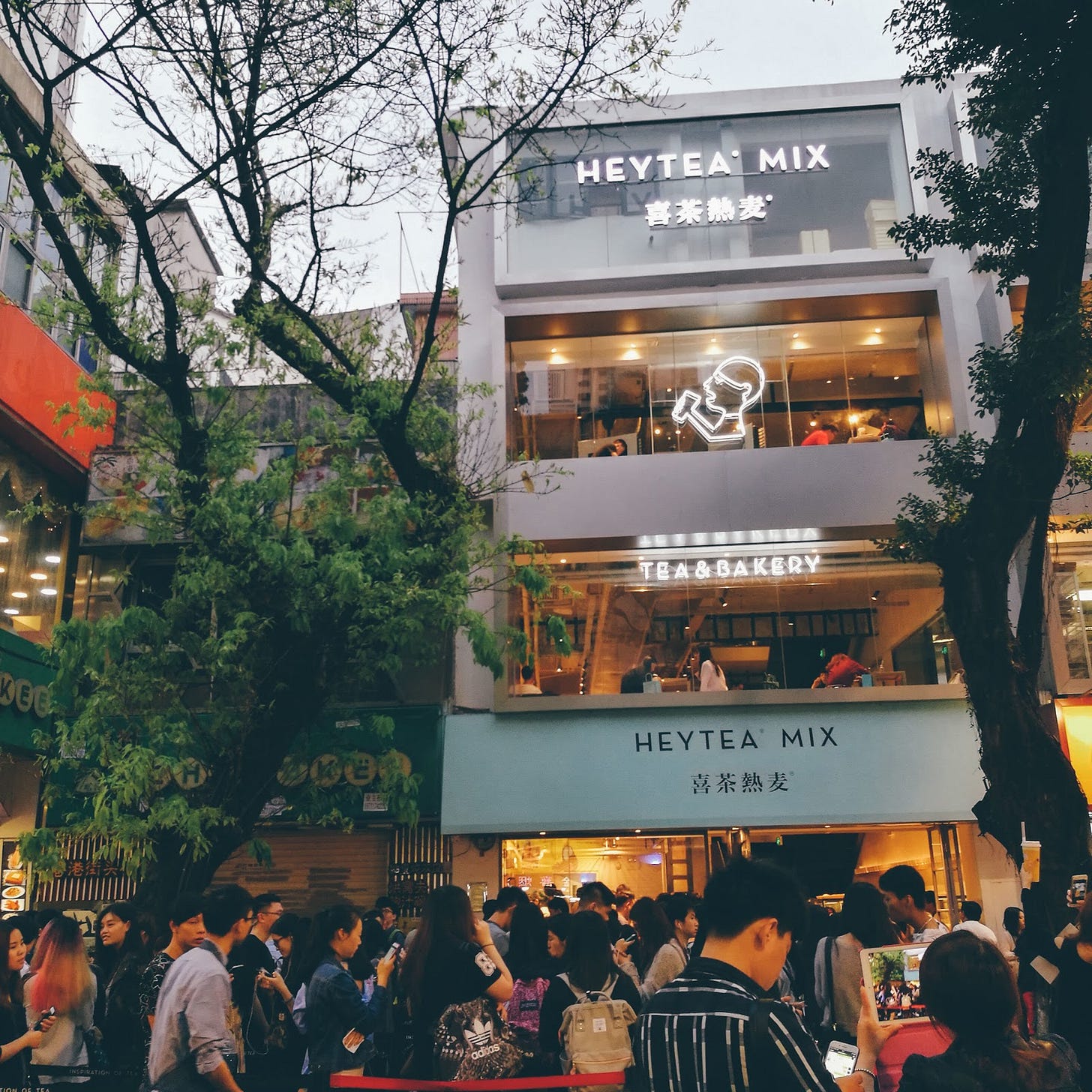I still remember the day the second HEYTEA store opened in Shanghai. It was an early morning in May 2017 and there was already a long line of people. My friend, a milk tea enthusiast, dragged me into line for a taste of the trendy tea drink that everyone had been raving about. I gave up after three hours but my friend waited three more hours and brought three different drinks home for us to try.
The hype lasted for at least another year. In the summer of 2018, when I walked past a HEYTEA store in a bustling mall in Shanghai, there was still a long line of excited customers winding back to the entrance of the mall. Starting as a small store in Guangdong, today HEYTEA has more than 500 stores in 43 cities and is on a mission to get to 800 by the end of 2020. It launched its first overseas store in Singapore in 2018.
The hype also attracted investment from top VC and tech companies, including Sequoia, IDG Capital, and Tencent, over just a few years. HEYTEA reportedly closed a new round of funding at a valuation of ¥16 billion (~$2.5 billion) in March 2020, led by Hillhouse Capital and Coatue Management.
How did a tea drink brand that started from nowhere turn into a national sensation and lead to a new tea drink movement that modern consumers are all addicted to?
Riding the wave of fresh-made tea
In January 1999, Starbucks entered the Chinese market by opening its first store in the China World Trade Building in Beijing. Its arrival challenged the Chinese tea-drinking tradition by introducing a chic culture of coffee-drinking. Later on, to cater to Chinese customers, Starbucks launched several tea drinks and quickly gained popularity with exotic flavors like Earl Grey and innovative ingredients like fruits in traditional tea. Seeing how Starbucks built almost a new lifestyle with a few drinks and taking inspiration from Hong Kong and Taiwan’s milk tea-drinking culture, a wave of street stores in mainland China started selling milk tea drinks near schools and malls. While they did increase awareness of milk tea drinks, these small-sized stores didn’t have much quality or earn much profit from the business; a whole industry still waited to be redefined.
Midway through the 2000s, brands such as Xiang Piao Piao and Youlemei started to promote instant milk tea products, using funny, cheesy catchphrases and celebrity endorsements to refresh young people’s perception of tea as “an older person’s drink.”
By the time HEYTEA opened a few years later, milk tea had become the go-to drink, inspiring sudden cravings in a generation of modern customers. According to Nikko Asset Management, we are currently at the stage of “Tea Generation 3.0,” characterized by fruit and innovative “milk caps,” and having evolved from “Generation 1.0,” marked by tea powder and non-dairy creamer and “Generation 2.0,” with its tea leaves and real milk.
HEYTEA’s decision to add fresh cheese to tea to make it milky and heavy-textured rode the wave of consumers’ rising preference for freshly made teas instead of milk tea powder mixed with water in a cup. Their innovative recipes successfully created product differentiation around the concept of “fun to drink.”
HEYTEA also put a lot of effort into reinventing the packaging. Traditional drink cups have a wider circumference, which doesn’t suit the main target customer: women. HEYTEA came up with a taller, narrower cup with a groove to prevent lipstick stains. Just as luxury fashion brands have come to adopt the sans-serif font as a means of attaching itself to concepts like “chic” and “modern”, HEYTEA is going after the same goal - leveraging a transparent cup to showcase the colorful drink inside, a bilingual brand name, and a stick figure of a person enjoying the drink. It’s quite different from the packaging of most milk tea drinks and adds a touch of “premium” that makes it worth being shared on social media.
Today the competition in the “new tea drink” market in China is fierce, with annual sales of between ¥40 billion and ¥50 billion ($6 billion–$7 billion), and HEYTEA is making low price one of its competitive advantages over recent market entrants. HEYTEA drinks are priced in the $3-$4 range, higher than the price of most fresh-made drinks in China, but around $1.50 cheaper than a cup of Starbucks coffee. According to Yunchen Nie, CEO of the HEYTEA brand, HEYTEA’s gross margin is below 50 percent, compared with the 80 percent gross margin typical of international coffee chains. HEYTEA has more freedom in competing with a lower price while maintaining its high quality image, based on its “cheap” marketing approach.
Saving marketing $$
Compared with its predecessors or even most DTC beverages brands in the US, HEYTEA relies less on celebrity endorsements and paid ads, but harnesses the power of word-of-mouth marketing. With the long lines in front of the store, the visually-appealing packaging, and its innovative cheese milk tea formula, HEYTEA has built the incentive to share into its DNA.
HEYTEA is just one of many viral lifestyle brands that have grown significantly over the past few years, where social platforms including Wechat Moments, Xiaohongshu (RED), Douyin (China’s TikTok) became the main places for people to connect and share their lives.
These viral brands are called “influencer stores,” not because they sponsor influencers to promote their brand, but because the brands themselves are earning eyeballs across social media through posts shared by all types of customers. Do a quick keyword search of “HEYTEA” on the lifestyle sharing platform RED, and you’ll find more than 180,000 posts discussing HEYTEA, most of them reviews of different flavors or hacks for counting the Macros or Calories of HEYTEA drinks.
People are willing to pay close to $5 for a drink because there’s both a social and emotional appeal associated with the purchase. There’s an element of signaling to your peers when you post a picture with the drink, what an industry spokesperson calls “affordable luxury”: “Even if you’re just making a few hundred dollars per month, you can buy this drink and show off. You can think ‘I am equal’ to someone wealthier.”
The souvenir of this “affordable luxury” doesn’t end with a social post: loyal consumers like to purchase merchandise of those brands to showcase their affection for it as well. Brand collaboration merch has become a popular way for brands to acquire customers from another vertical and increase exposure to the general public. HEYTEA has launched collabs with popular brands and IPs, including Sesame Street, L’Oréal, and Absolut vodka.
During the Chinese Spring Festival in 2019, HEYTEA partnered with clothing brand Peacebird, which has been going after younger customers in recent years with a chic brand style, to launch a series of festive products such as red envelopes, red hoodies, red teacup sleeves, and red Mahjong (with the color red symbolizing luck, joy, and happiness in Chinese culture).
Through its partnership, HEYTEA wants to remind consumers that their drinks should be viewed as an accessory of your day to day life, that it’s not just any drink but a statement that embodies an attitude of celebration and enjoyment of everyday life.
The battle in the new tea market
Since HEYTEA disrupted the tea drink market in 2017, quite a few brands have joined the game and grown quickly, including Modern China Tea Shop, LELECHA, and NAYUKI. NAYUKI, regarded as HEYTEA’s No.1 competitor, raised funds through a Series A+ financing round led by Tiantu Capital in 2018, bringing the valuation of the company to ¥6 billion (~$916 million).
As these brands start on an expansion sprint in competition for the key market, the battle is no longer about customer acquisition, which HEYTEA excelled at through its word-of-mouth marketing. Now their attention is focused on retaining those customers, where the core product, operations, and brand management can together make or break the business.
For example, to reduce long wait times, HEYTEA launched the “HEYTEA Go” mini-app on WeChat, which allows customers to order online and pick up in a “Go” store, usually located near office buildings. The app helps to improve efficiency and user experience while collecting valuable customer data on their drink preferences for future targeting.
The expansion into pastry is another trend that all the tea drink brands are betting on. With tea drinks and soft buns becoming a basic formula for these brands, they hope to become consumers’ go-to place for a break with a drink and a snack. HEYTEA launched its first “HEYTEA Mix” store back in 2017, selling bakery items and tea to satisfy customers’ thirst and hunger.
HEYTEA has been having fun launching theme stores such as HEYTEA Pink, drawing female customers to visit, purchase, and share the whole experience on social media. Similarly, there’s also HEYTEA Black, where a limited selection of drinks is served, and HEYTEA Lab, where customers can engage in the fresh tea brewing experience.
Brands of all kinds, but especially top brands in the food and beverages space, are building creative spaces, selling merch, and launching cross-space partnerships, in an effort to attract consumers who are looking for not just a single product transaction, but an experience. These consumers want an interaction with the brands they are passionate about and feel are worth sharing with others. Most competitors in the Food & Beverage industry know how to excel at providing tasty products and efficient operations, which leaves little room to differentiate themselves. By building the brand’s character and speaking to consumers through its liveliness and uniqueness, a brand can win the hearts of this generation’s consumers, for whom “fun” is an essential element, even when shopping for a cup of tea and a bun.
HEYTEA wins with a storytelling approach to creating an experience for its customers, who believe life is more than just work and daily problems, and with a simple tea drink, they can transform the routine into something more, a mellow yet solid sense of happiness with a carpe diem attitude. With continuous innovation, HEYTEA constantly refreshes its story with a competitive product offering of experimental flavors, innovative packaging designed for its core audience, and lively, varied physical spaces. With seasonal limited drinks like taro in the winter and peach in the summer, HEYTEA creates a “what’s next?” to-be-surprised element for its customers, making tea-drinking a theme through the four seasons, as well as big or small celebration moments in their lives.
As the popular YouTube creators, the Fung Bros, sing in their song “Bobalife”, “We’re livin’ the boba life.”
Tea drinking is as much an identity shoutout as it is a lifestyle.












